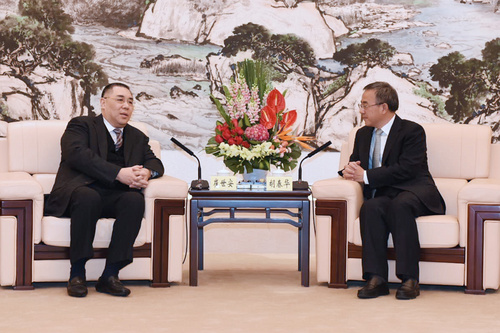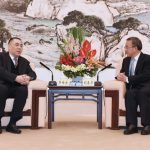 The Guangdong-Macao high-level meeting on the development of the “Belt and Road” initiative takes place in Guangzhou Prefecture, Guangdong Province.
The Guangdong-Macao high-level meeting on the development of the “Belt and Road” initiative takes place in Guangzhou Prefecture, Guangdong Province.
The Chief Executive, Mr Chui Sai On, today said participation in the development of the “Belt and Road” initiative would complement Guangdong-Macao ties, and in particular advance the two places’ development goals.
Mr Chui was speaking to reporters while in Guangzhou Prefecture in Guangdong Province following a Guangdong-Macao high-level meeting on the development of the “Belt and Road” initiative.
The meeting – also attended by the Secretary of the CPC Guangdong Provincial Committee, Mr Hu Chunhua, and the Governor of Guangdong, Mr Ma Xingrui –discussed paths to strengthening trade and investment, people-to-people exchanges between the two places, and the plan for such arrangements.
Macao’s involvement in the country’s development of the Silk Road Economic Belt and the 21st-Century Maritime Silk Road (collectively known as the “Belt and Road” initiative) is part of the city’s strategic development programme.
The meeting agreed the following three objectives as part of Guangdong-Macao joint efforts regarding the development of the “Belt and Road” initiative:
1) To achieve the goals set out in the letter of intent between Guangdong Province and the Macao Special Administrative Region regarding joint participation in the development of the “Belt and Road” Initiative, which was signed during the Guangdong-Macao Cooperation Joint Conference in June 2016;
2) To boost trade and investment cooperation via:
- Macao assisting Guangdong in establishing closer ties and further exchanges with Portuguese-speaking countries and Southeast Asian countries;
- Macao providing financial services to assist Guangdong to increase the number of investments it makes in Portuguese-speaking countries;
- Attendance by people from the two places at a greater number of promotional events on the mainland and overseas in order to encourage investment with and in countries and places covered in the “Belt and Road” initiative;
- Further promotion of the “Belt and Road” initiative during Macao and Guangdong’s respective major events and conferences, and;
- Pressing ahead with the development of "Dawan area" – a logistics hub in coastal areas encompassing Guangdong, Hong Kong and Macao.
3) To enhance people-to-people exchange and cooperation in cultural and social affairs via:
- Optimisation of the facilitated travel scheme for pleasure craft users or owners that wish to sail between Guangdong and Macao, and of the multi-destination tourism scheme: in both cases in order to enrich the tourism component in the “Belt and Road” initiative;
- Encouragement of further exchanges among associations from the two places of returned overseas Chinese, and;
- Advancement of cooperation on traditional Chinese medicine, based on the foundation of the “Framework Agreement on Cooperation Between Guangdong and Macao”.
The Chief Executive announced that Macao would establish a fund for facilitating further cultural exchanges between countries and places covered in the “Belt and Road” initiative, in particular, for exchanges involving Portuguese-speaking countries and Southeast Asian countries.
Mr Chui on Wednesday (22 February) met officials from Fujian Province – at a Fujian-Macao high-level meeting on the development of the “Belt and Road” initiative – to discuss how to advance joint efforts for the development of the “Belt and Road” initiative and how to quicken the pace of complementary cooperation in several fields.
Mr Chui said Macao, Guangdong and Fujian strive to facilitate the involvement of the public in the development of the “Belt and Road” initiative.
The nurturing of talented young people in order to carry out the development activities generated by the “Belt and Road” initiative was a shared interest of the three places, he added. The three governments would organise more visits in order that young people would be able to visit countries and places covered by the “Belt and Road” initiative with the aim of promoting a better understanding of the country’s development strategy, said Mr Chui.
Following guidance from the Central Government, trade and investment and people-to-people exchanges were identified as two major areas where Macao could explore broader cooperation with Fujian and Guangdong. Macao could do so while pressing ahead with its contribution to the “Belt and Road” initiative, said Mr Chui.
The approach to cooperation would vary according to the province involved. For example, Macao could utilise Fujian’s network of returned overseas Chinese in order to explore cooperation with countries and places covered by the “Belt and Road” initiative. In the case of Guangdong, cooperation could focus more on the development of free trade zones, in particular via the Hengqin area.
Members of the Macao delegation visiting Guangzhou included: the Chief-of-Office of the Chief Executive’s Office, Ms O Lam; the Director of the Government Information Bureau, Mr Chan Chi Ping; the Director of the Policy Research Office, Mr Lao Pun Lap; the Director of the Protocol, Public Relations and External Affairs Office, Mr Fung Sio Weng; the President of the Administrative Committee of the Macao Trade and Investment Promotion Institute, Mr Cheong Chou Weng; the Director of the Macao Government Tourism Office, Ms Maria Helena de Senna Fernandes; the Chairperson of the Board of Directors of Macau Investment and Development Limited, Ms Lu Hong; and Adviser to the Chief Executive’s Office, Mr Kou Chin Hung.


